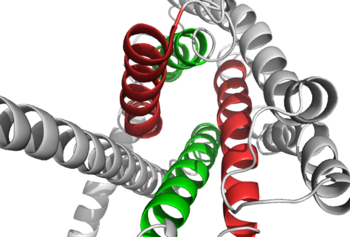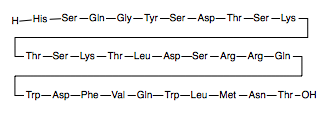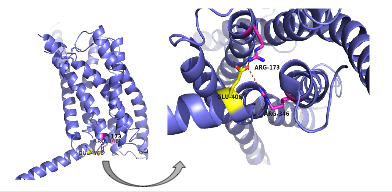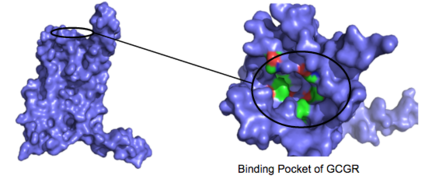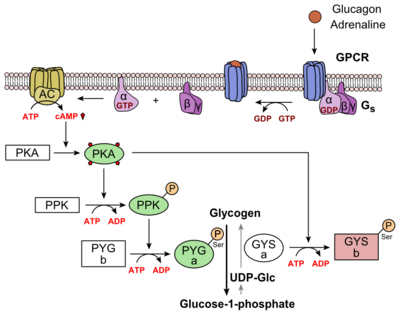Sandbox Reserved 1165
From Proteopedia
(Difference between revisions)
| Line 40: | Line 40: | ||
Research for class B GCGR [https://en.wikipedia.org/wiki/Enzyme_inhibitor inhibitors] is primarily looking into [https://en.wikipedia.org/wiki/Allosteric_regulation allosteric inhibitors] having the ability to target specific receptors in order to treat problems like [https://en.wikipedia.org/wiki/Stress-related_disorders stress disorders], managing [http://www.webmd.com/diabetes/guide/diabetes-hyperglycemia hyperglycemia], and also alternative mechanisms for treating [https://en.wikipedia.org/wiki/Migraine migraines]. <ref name="Inhibitors">PMID: 24189067</ref> Known inhibitors include [https://en.wikipedia.org/wiki/Monoclonal_antibody monoclonal antibodies] which inhibit glucagon receptors through an allosteric mechanism. The monoclonal antibodies bind to two different sites, the ECD opposite of the binding region and then the helical portion of the ECD as well. <ref name="Last">PMID: 19305799</ref> | Research for class B GCGR [https://en.wikipedia.org/wiki/Enzyme_inhibitor inhibitors] is primarily looking into [https://en.wikipedia.org/wiki/Allosteric_regulation allosteric inhibitors] having the ability to target specific receptors in order to treat problems like [https://en.wikipedia.org/wiki/Stress-related_disorders stress disorders], managing [http://www.webmd.com/diabetes/guide/diabetes-hyperglycemia hyperglycemia], and also alternative mechanisms for treating [https://en.wikipedia.org/wiki/Migraine migraines]. <ref name="Inhibitors">PMID: 24189067</ref> Known inhibitors include [https://en.wikipedia.org/wiki/Monoclonal_antibody monoclonal antibodies] which inhibit glucagon receptors through an allosteric mechanism. The monoclonal antibodies bind to two different sites, the ECD opposite of the binding region and then the helical portion of the ECD as well. <ref name="Last">PMID: 19305799</ref> | ||
===Research=== | ===Research=== | ||
| - | Determining the structure of class B GCGRs is a reason for its lack of advanced knowledge in the field, but [https://en.wikipedia.org/wiki/X-ray_crystallography X-ray crystallography] and [https://en.wikipedia.org/wiki/Nuclear_magnetic_resonance NMR] have been the main processes performed and have had some success with it over the past couple years <ref name="Lastt">PMID: 26227798</ref> | + | Determining the structure of class B GCGRs is a reason for its lack of advanced knowledge in the field, but [https://en.wikipedia.org/wiki/X-ray_crystallography X-ray crystallography] and [https://en.wikipedia.org/wiki/Nuclear_magnetic_resonance NMR] have been the main processes performed and have had some success with it over the past couple years. <ref name="Lastt">PMID: 26227798</ref> X-ray crystallography displayed the [https://en.wikipedia.org/wiki/Crystal_structure crystal structure] of ECDs of class B GPCRs in complex with their [https://en.wikipedia.org/wiki/Ligand ligands] along with the crystal structure of the 7TM. In addition to this, NMR has allowed the ability to directly understand structures of soluble amino-terminal domains of numerous members of the secretin-like family that bind [https://en.wikipedia.org/wiki/Peptide_hormone peptide hormones]. Primary sequences analysis have led to the finding of seven segments of eighteen or more relatively hydrophobic residues that are believed to represent transmembrane helices that take part in creating an intramembranous helical bundle. <ref name="Lastt">PMID: 26227798</ref> Also, [https://en.wikipedia.org/wiki/Mutagenesis mutagenesis] has been used to determine which residues were necessary in maximizing affinity for glucagon. Finally, the orientation and mechanism of the peptide interactions within these structures are studied using peptide structure-activity relationships (SAR), receptor and ligand fragments, chimeric receptors, site-directed mutagenesis, photochemical cross-linking, and molecular modeling. <ref name="Lastt">PMID: 26227798</ref> |
</StructureSection> | </StructureSection> | ||
Revision as of 13:10, 12 April 2016
References
- ↑ 1.0 1.1 Hollenstein K, de Graaf C, Bortolato A, Wang MW, Marshall FH, Stevens RC. Insights into the structure of class B GPCRs. Trends Pharmacol Sci. 2014 Jan;35(1):12-22. doi: 10.1016/j.tips.2013.11.001. Epub, 2013 Dec 18. PMID:24359917 doi:http://dx.doi.org/10.1016/j.tips.2013.11.001
- ↑ 2.0 2.1 2.2 2.3 2.4 2.5 Siu FY, He M, de Graaf C, Han GW, Yang D, Zhang Z, Zhou C, Xu Q, Wacker D, Joseph JS, Liu W, Lau J, Cherezov V, Katritch V, Wang MW, Stevens RC. Structure of the human glucagon class B G-protein-coupled receptor. Nature. 2013 Jul 25;499(7459):444-9. doi: 10.1038/nature12393. Epub 2013 Jul 17. PMID:23863937 doi:10.1038/nature12393
- ↑ 3.0 3.1 Miller LJ, Dong M, Harikumar KG. Ligand binding and activation of the secretin receptor, a prototypic family B G protein-coupled receptor. Br J Pharmacol. 2012 May;166(1):18-26. doi: 10.1111/j.1476-5381.2011.01463.x. PMID:21542831 doi:http://dx.doi.org/10.1111/j.1476-5381.2011.01463.x
- ↑ Thomsen J, Kristiansen K, Brunfeldt K, Sundby F. The amino acid sequence of human glucagon. FEBS Lett. 1972 Apr 1;21(3):315-319. PMID:11946536
- ↑ Bortolato A, Dore AS, Hollenstein K, Tehan BG, Mason JS, Marshall FH. Structure of Class B GPCRs: new horizons for drug discovery. Br J Pharmacol. 2014 Jul;171(13):3132-45. doi: 10.1111/bph.12689. PMID:24628305 doi:http://dx.doi.org/10.1111/bph.12689
- ↑ Mukund S, Shang Y, Clarke HJ, Madjidi A, Corn JE, Kates L, Kolumam G, Chiang V, Luis E, Murray J, Zhang Y, Hotzel I, Koth CM, Allan BB. Inhibitory mechanism of an allosteric antibody targeting the glucagon receptor. J Biol Chem. 2013 Nov 4. PMID:24189067 doi:http://dx.doi.org/10.1074/jbc.M113.496984
- ↑ Hoare SR. Allosteric modulators of class B G-protein-coupled receptors. Curr Neuropharmacol. 2007 Sep;5(3):168-79. doi: 10.2174/157015907781695928. PMID:19305799 doi:http://dx.doi.org/10.2174/157015907781695928
- ↑ 8.0 8.1 8.2 Yang L, Yang D, de Graaf C, Moeller A, West GM, Dharmarajan V, Wang C, Siu FY, Song G, Reedtz-Runge S, Pascal BD, Wu B, Potter CS, Zhou H, Griffin PR, Carragher B, Yang H, Wang MW, Stevens RC, Jiang H. Conformational states of the full-length glucagon receptor. Nat Commun. 2015 Jul 31;6:7859. doi: 10.1038/ncomms8859. PMID:26227798 doi:http://dx.doi.org/10.1038/ncomms8859
